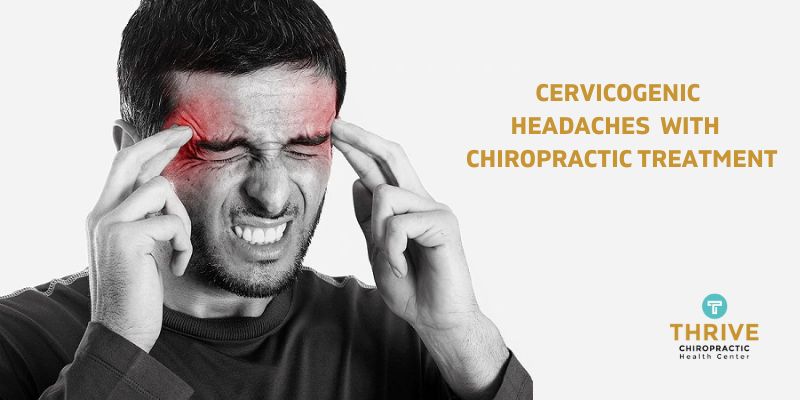Chiropractic care involves various techniques for managing and preventing headaches. While commonly used to address physical pain and issues, chiropractic treatment is also effective in treating cervicogenic headaches.

What Is A Cervicogenic Headache?
Cervicogenic headache is a particular type of headache that develops in the cervical spine or neck region. “Cervicogenic” is the term that denotes that the pain may be felt in the head and that it originates from neck-related structures.
Cervicogenic headache is believed to be related to the neck’s nerves, muscles and joints, though their exact cause is unknown. These headaches can be triggered by many conditions, such as inflammation of the cervical nerves or joints, imbalances or muscle tension in the neck, poor posture, cervical spine degeneration and whiplash-related neck trauma.
Symptoms Of Cervicogenic Headaches
A cervicogenic headache is defined as a headache that originates from one side of the head and it changes in intensity with the movement of the head. Typically, the pain radiates to the front from the back of the head. Cervicogenic headaches are typically described differently than throbbing or stabbing pain, despite being very painful.
If you frequently suffer from cervicogenic headaches, you will have restricted neck mobility and may also experience arm, shoulder or neck pain on the same side as the headache.
It is important to differentiate cervicogenic headaches from other conditions with similarities, such as tension-type headaches and migraines, both of which can cause stiffness in the neck. A doctor must also rule out occipital neuralgia, which is a pain in one of the nerves that run up the back of the head.
Chiropractic Treatment For Cervicogenic Headaches
It is important to be aware that a cervicogenic headache could be the cause of your severe headaches. This type of headache typically causes pain on one side of the head, which begins in the back and moves forward. Another sign might be a recurring shoulder or arm ache that moves from one side to the other.
Most people think that underlying neck problems are the cause of cervicogenic headaches. This implies that an injury could unintentionally cause this kind of headache. Cervicogenic headaches are less common than other types of headaches, and they typically do not respond to treatment medications quickly.
As a result, chiropractic treatments like spinal manipulation can effectively treat these headaches.
For efficient management of this condition, here are some chiropractic therapies that can be used…

1. Spinal Manipulation
Chiropractors frequently use the technique of spinal manipulation; To apply a controlled force to specific bone joints, this therapy uses specialized devices. You might hear an unexpected noise coming from your spine as the force is applied.
The cervical bones, which are found in the neck region at the top of the spine, are the bones that will receive treatment. You might also get a massage that focuses on this region as part of spinal manipulation to treat cervicogenic headaches.
2. Exercise Involving Deep Neck Flexing
Under the direction of a chiropractor, you might want to try neck flexion exercises. Your muscles and joints will be actively moved during this procedure.
Your doctor will give you specific flexion exercises to do like chin tucks and head nods while you are face down. You can perform these exercises by contracting your muscles for a few seconds each time until you feel relief. These exercises are designed to give the neck a deep stretch and increase its flexibility. This ultimately reduces the headache.
3. Joint Mobilization
A common therapeutic technique used to treat cervicogenic headaches is joint mobilization. It involves the chiropractor and careful application of manual force to specific neck joints to ease pain and extend the range of motion in the head. Also, the chiropractor manipulates the targeted joint with gentle oscillatory movements or persistent pressure during joint mobilization. These methods help to release tension, stiffness and restrictions within the joint structures. Joint mobilization can help to lessen the symptoms of cervicogenic headaches by promoting proper joint alignment and regaining optimal function.
4. Trigger Point Therapy
Chiropractic care has proven to be highly effective in lessening the severity of severe headaches. Chiropractic adjustments may also provide pain relief in the area of the neck that is connected to the problem. This technique also promotes the flexibility and mobility of a person’s neck muscles.
Furthermore, trigger point therapy is one particular technique that chiropractors use to treat headaches because it focuses on and relieves trigger points. With the help of this technique, certain neck regions under the skeletal muscles can be relieved of chronic pain, stress and anxiety.
Additionally, trigger point therapy is frequently combined by chiropractors with other forms of care, including spinal mobilization, spinal adjustments and functionally restoring exercises. Chiropractors can efficiently manage and treat cervicogenic headaches by using a thorough treatment plan.
5. Advice On Postural Correction
Chiropractic care for cervicogenic headaches must include postural correction. Cervicogenic headaches can be brought on by (or made worse by) poor posture, which can also lead to muscle imbalances and strain on the neck and cervical spine.
For a thorough assessment and individualized advice on posture correction exercises and techniques, it is important to speak with a chiropractor. They can offer advice that is specific to your situation and can help in addressing any underlying problems that may be causing your cervicogenic headaches.
Summary:
A variety of techniques can be used to treat cervicogenic headaches. To reduce pain and improve neck flexibility, these treatments concentrate on the neck’s spinal region. Common chiropractic treatments for cervicogenic headaches include joint mobilization, trigger point therapy, neck flexion exercises and spinal manipulation.








